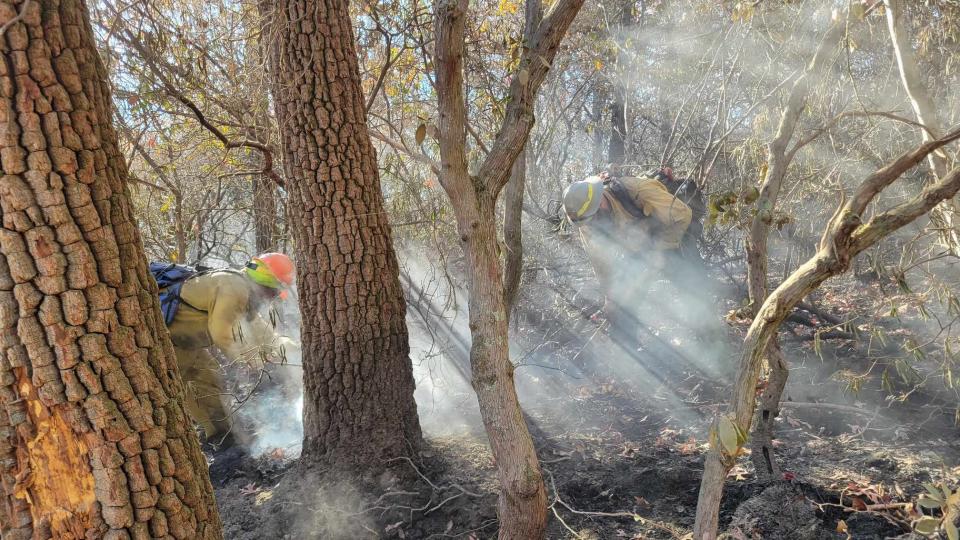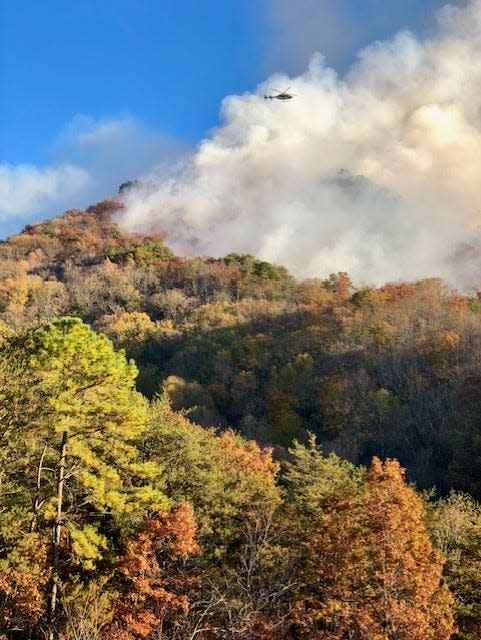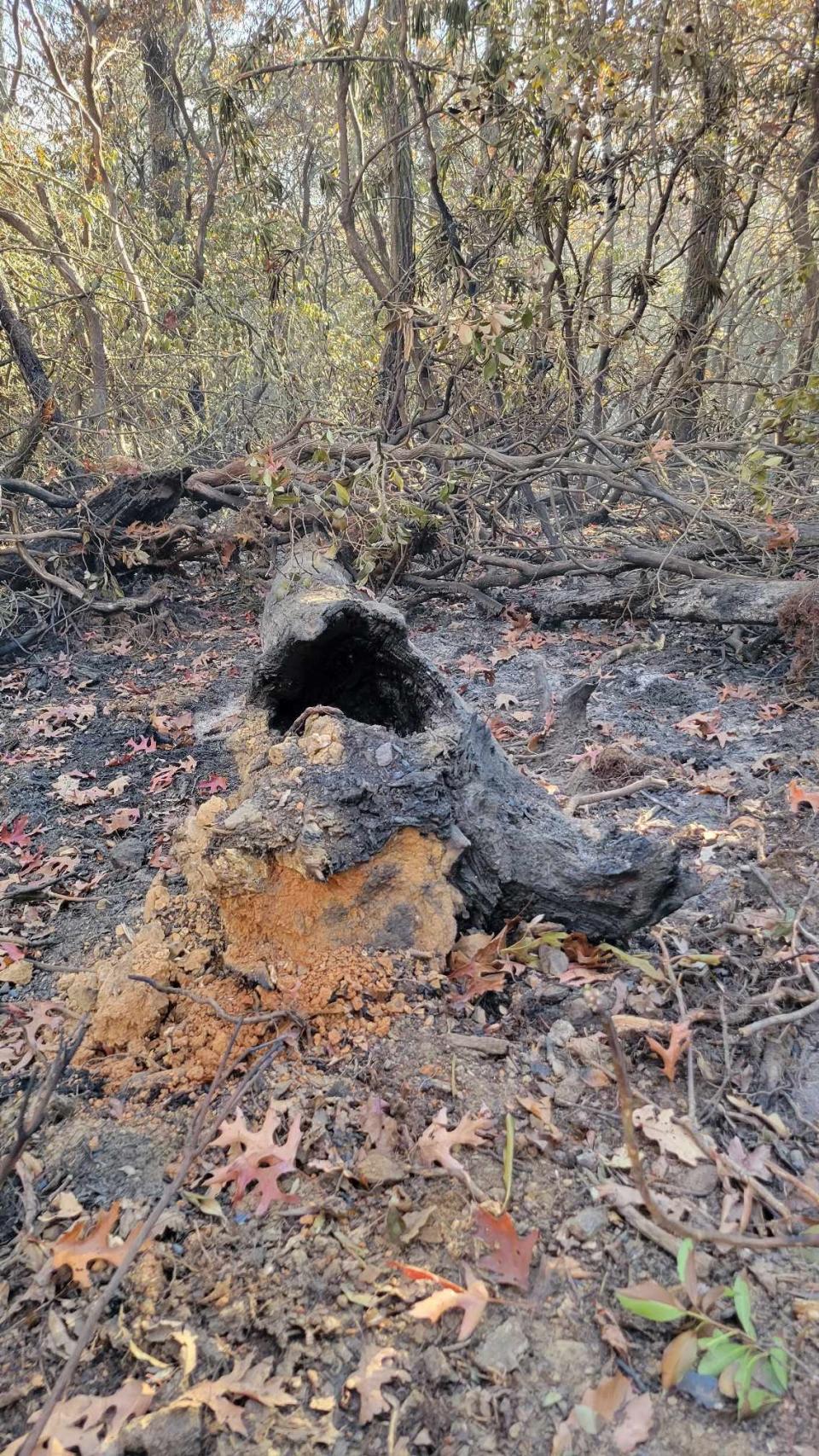Is there anything good about wildfires? Experts talk about benefits of WNC wildfires
EDNEYVILLE - As frightening and threatening as wildfires can be in Western North Carolina, there are some positives to take away from the flames, according to experts.
The Poplar Drive Fire in Edneyville began on Nov. 3 and as of Nov. 19 was completely contained at 100%, according to the North Carolina Forest Service. Other wildfires in Western North Carolina are also getting close to total containment.

These are the updates on Nov. 19 by the Forest Service:
The Black Bear Fire is burning in Haywood County on the Appalachian Ranger District of the Pisgah National Forest and is currently 1,720 acres and 0% contained. The fire started Nov. 16, resulting from a traffic accident on Interstate 40 near the NC/TN border.
The Branch Fire in Wilkes County, which started Nov. 9, has reached 100% containment. The fire will continue to be patrolled and monitored by N.C. Forest Service personnel.
The Collett Ridge Fire, burning in Cherokee and Clay counties, is 5,505 acres and 82% contained. The Collett Ridge Fire is being managed under unified command by the U.S. Forest Service and N.C. Forest Service.
More: Answer Man: Is Asheville at increased wildfire risk? How can we protect our homes?

How fires are beneficial
According to the National Park Service, fires are part of a forest's cycle in most ecosystems from an article on its website www.nps.gov, which talked about the benefits of fires in national parks.
"It reduces dead vegetation, stimulates new growth and improves habitat for wildlife, many of the details park visitors imagine when they think of a national park," the article said. "With fire suppression, fire was removed from the cycle and ecosystems began to get out of balance."
Professor Jonathan Horton, department chair of the biology department at UNC Asheville, told the Times-News on Nov. 14 that benefits depend on the forest type that is burned.
More: Florida man charged with starting Edneyville wildfire, Forest Service reports
"We have a high diversity of forest types, some of which are actually dependent on fire. Fires can be beneficial by helping to break down leaf litter, releasing nutrients into the soil and creating safe spaces for germination," he said. "However, the timing of fire is important. If the fire burns after seeds have fallen, then it may kill the seeds. A lot depends on the fire intensity."
Adrianne Rubiaco, fire information officer for North Carolina with the U.S. Forest Service, said in the Southern Appalachians, the ecosystems benefit from the low-to-moderate intensity fires.
"Historically fire has been on this landscape and has returned naturally in what we call fire intervals," she told the Times-News on Nov. 16. "In doing so, it has positive effects on the ecosystem. For wildlife, it improves their foraging habitat with the food that they eat. It also improves the living conditions as well by clearing out a lot of that underbrush. For animals in this area, it's beneficial to the deer and turkeys as well."
Rubiaco said the fire also rejuvenates the soil.
"It promotes regrowth of native plant species, specifically like certain wildflowers in the area that are pollinators," she said.
More: Endangered snail survives devastating fall wildfires

The recovery process
Horton and Rubiaco both said the recovery of a forest after a fire depends mostly on how intense the fire was.
"Generally, if the fire was a low intensity ground fire, like many in our area, there is minimal long-term impact and forests recover quickly. Many tree seedlings (like oaks) and shrubs (like mountain laurel and rhododendron) may be top-killed but often can re-sprout readily from roots," he said.
"We did a study on Shumont Mountain in 2017 after the 2016 Party Rock fire, and many of the shrubs had re-sprouted. Now, you would be hard pressed to notice the fire effects," he said of the fire that burned in Buncombe, Henderson and Rutherford counties.
He said the wildfires of 2016 in WNC were intense, with more extensive damage. Extended drought conditions in 2016 across WNC contributed to 34 wildfires, including Party Rock, that burned throughout November, eventually burning some 60,000 acres of forest. They also led to 14 deaths in Gatlinburg, Tennessee, after the Chimney Tops Fire that started in Great Smoky Mountains National Park raged outside the park's borders.
More: Farmland vanishing: Developers paying big bucks for Henderson County property
"If more of the soil is disturbed, either by the fire of after fire erosion, that will make it harder and take longer to recover," he said.
As for the recent fires, which were mostly low intensity, Rubiaco said the recovery process is accelerated.
"It can really be by next spring, especially with these fall fires. You can begin to see rejuvenation and regrowth once spring comes," she said.
Rubiaco said the U.S. Forest Service conducts prescribed burns, which mimic natural fire occurrences.
"We've done those where by the next growing season, you can't tell. If anything, it just seems more open. Those openings bring sunlight to ground floor, which improves that habitat," she said.
As for those prescribed burns, they can also be beneficial to future fires, Rubiaco said.
"Like the Collett Ridge Fire, it actually burned into an area that we did conduct a prescribed burn this past spring. It's actually now holding within that area and burning at a lower intensity than it potentially would have," she said.
Answer Man: Is Asheville at increased wildfire risk? How can we protect our homes?
Safety tips
To protect the home from surface fires, homeowners should take these steps, according to past Citizen Times reporting:
Clear fuel from the immediate area surrounding the house, including gathering or taking down dead leaves, trees and plants from the area immediately surrounding the home
Property owners should try to clear the area 100 feet from the home of dead vegetation and debris
Homeowners need to make sure they have a green space around their property
To protect from flying embers, homeowners need to clear the leaves and pine needles from their gutters, and remove dead leaves and debris from their roofs
People can surround their homes with rocks instead of mulch or develop a gravel buffer in the immediate area around their homes
Dean Hensley is the news editor for the Hendersonville Times-News. Email him with tips, questions and comments at DHensley@gannett.com. Please help support this kind of local journalism with a subscription to the Hendersonville Times-News.
This article originally appeared on Hendersonville Times-News: Western North Carolina wildfires have benefits experts say

